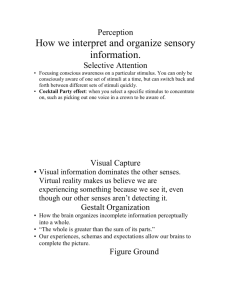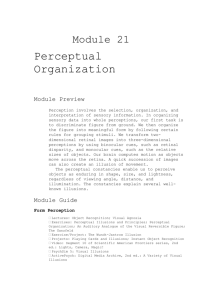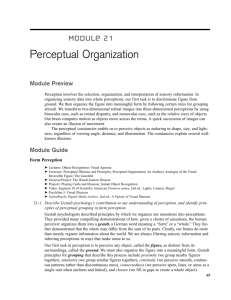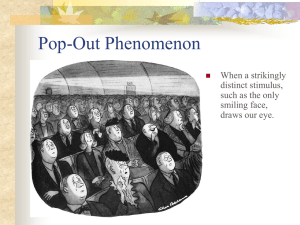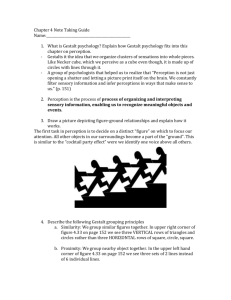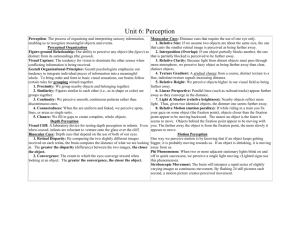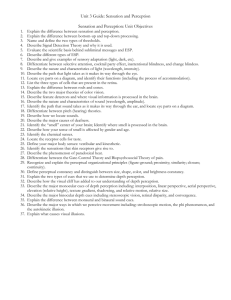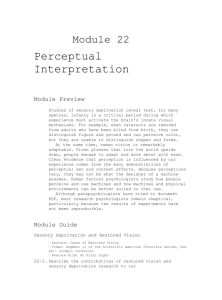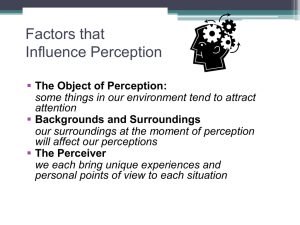File - Thrive in AP Psychology
advertisement
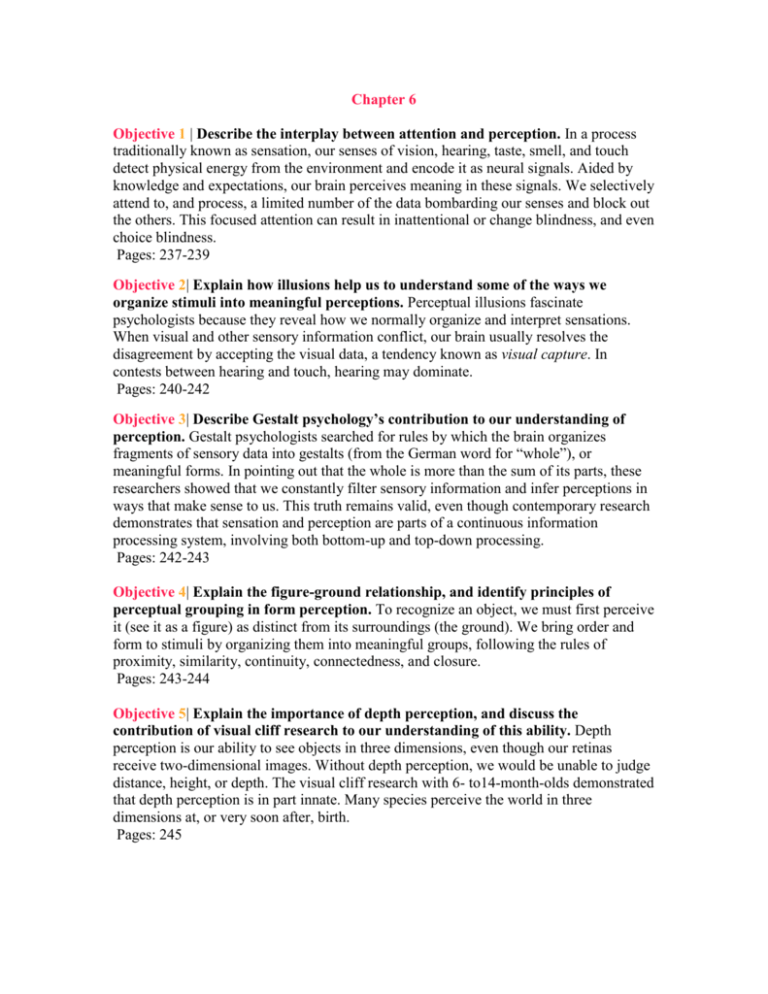
Chapter 6 Objective 1 | Describe the interplay between attention and perception. In a process traditionally known as sensation, our senses of vision, hearing, taste, smell, and touch detect physical energy from the environment and encode it as neural signals. Aided by knowledge and expectations, our brain perceives meaning in these signals. We selectively attend to, and process, a limited number of the data bombarding our senses and block out the others. This focused attention can result in inattentional or change blindness, and even choice blindness. Pages: 237-239 Objective 2| Explain how illusions help us to understand some of the ways we organize stimuli into meaningful perceptions. Perceptual illusions fascinate psychologists because they reveal how we normally organize and interpret sensations. When visual and other sensory information conflict, our brain usually resolves the disagreement by accepting the visual data, a tendency known as visual capture. In contests between hearing and touch, hearing may dominate. Pages: 240-242 Objective 3| Describe Gestalt psychology’s contribution to our understanding of perception. Gestalt psychologists searched for rules by which the brain organizes fragments of sensory data into gestalts (from the German word for “whole”), or meaningful forms. In pointing out that the whole is more than the sum of its parts, these researchers showed that we constantly filter sensory information and infer perceptions in ways that make sense to us. This truth remains valid, even though contemporary research demonstrates that sensation and perception are parts of a continuous information processing system, involving both bottom-up and top-down processing. Pages: 242-243 Objective 4| Explain the figure-ground relationship, and identify principles of perceptual grouping in form perception. To recognize an object, we must first perceive it (see it as a figure) as distinct from its surroundings (the ground). We bring order and form to stimuli by organizing them into meaningful groups, following the rules of proximity, similarity, continuity, connectedness, and closure. Pages: 243-244 Objective 5| Explain the importance of depth perception, and discuss the contribution of visual cliff research to our understanding of this ability. Depth perception is our ability to see objects in three dimensions, even though our retinas receive two-dimensional images. Without depth perception, we would be unable to judge distance, height, or depth. The visual cliff research with 6- to14-month-olds demonstrated that depth perception is in part innate. Many species perceive the world in three dimensions at, or very soon after, birth. Pages: 245 Objective 6| Describe two binocular cues for perceiving depth, and explain how they help the brain to compute distance. Binocular cues are depth cues that rely on information from both eyes. In the retinal disparity cue, the brain computes the relative distance of an object by comparing the slightly different images the object casts on our two retinas. The greater the difference, the closer the object must be. In the convergence cue, the brain calculates the degree of neuromuscular strain when our two eyes turn inward to look at a nearby object. The greater the strain (or the angle of convergence), the closer the object. Pages: 245-246 Objective 7 | Explain how monocular cues differ from binocular cues, and describe several monocular cues for perceiving depth. Monocular cues let us judge depth using information transmitted by only one eye; binocular cues require information from both eyes. Monocular cues include • relative size (smaller is more distant).• interposition (an object that blocks another is closer than the blocked object). • relative clarity (a hazy object is farther away than an object seen clearly). • texture gradient (when texture changes, coarse distinct objects are close and fine indistinct objects are distant). • relative height (objects higher in our field of vision are farther away). • relative motion or motion parallax (when you are moving, objects closer than a fixation point appear to move backward—the nearer the object, the faster it moves; objects beyond the fixation point appear to move with you). • linear perspective (the more two parallel lines converge, the farther away they are). • light and shadow (nearby objects reflect more light than faraway objects). Pages: 246-249 Objective 8| State the basic assumption we make in our perceptions of motion, and explain how these perceptions can be deceiving. As objects move across or toward our retinas, our basic assumption is that shrinking objects are retreating, and enlarging objects are approaching. But our perception of motion is not always trustworthy. We may miscalculate the speed of movement of large objects or objects picked up by our peripheral vision. A quick succession of images on the retina can create an illusion of movement, as in stroboscopic movement (triggered by a rapid series of slightly varying images) or the phi phenomenon (triggered by the rapid on-off blinking of two adjacent stationary lights). Pages: 249-250 Objective 9| Explain the importance of perceptual constancy. Perceptual constancy is necessary in vision to recognize an object, regardless of its changing angle, distance, or illumination. Because of this ability, we perceive objects as having unchanging characteristics despite the changing images they cast on our retinas. Pages: 250 Objective 10 | Describe the shape and size constancies, and explain how our expectations about perceived size and distance contribute to some visual illusions. Shape constancy is our ability to perceive familiar objects (such as an opening door) as unchanging in shape, and size constancy perceives objects as unchanging in size, despite the changing images they cast on our retinas. There is a close relationship between perceived size and perceived distance. Knowing an object’s size gives us clues to its distance; knowing its distance gives clues about its size. This interplay sometimes misleads us, as when we misread monocular distance cues and reach the wrong conclusions, as in the Moon, Ponzo, and Müller-Lyer illusions. Pages: 251-252 Objective 11 | Discuss lightness constancy and its similarity to color constancy.Lightness (or brightness) constancy is our ability to perceive an object as having a constant lightness even when its illumination—the light cast upon it— changes. Color constancy enables us to perceive the color of an object as unchanging even when its illumination changes. In both cases, the brain perceives the quality (lightness or color) relative to surrounding objects. Pages: 253 Objective 12 | Describe the contribution of restored-vision and sensory deprivation research in our understanding of the nature nurture interplay in our perceptions. If all aspects of visual perception were entirely inborn, people who were born blind but regained sight after surgery should have normal visual perception. They do not. After cataract surgery, for example, adults who had been blind from birth are able to distinguish figure from ground and to perceive colors, but they lack the experience to recognize shapes, forms, and complete faces. Further evidence comes from animals reared with severely restricted visual input, who suffered enduring visual handicaps when their visual exposure was returned to normal. Clinical and experimental evidence indicates that there is a critical period for some aspects of sensory and perceptual development. Without the stimulation provided by early visual experiences, the brain’s neural organization does not develop normally. Pages: 255-256 Objective 13 | Explain how the research on distorting goggles increases our understanding of the adaptability of perception. When people are given glasses that shift the world slightly to the left or right, or even turn it upside down, they are initially disoriented, but they manage to adapt to their new context and, with practice, to move about with ease. This research demonstrates our ability to adjust to an artificially altered visual field and coordinate our movements in response to that new world. Pages: 256-257 Objective 14| Define perceptual set, and explain how it influences what we do or do not perceive. Perceptual set is a mental predisposition that functions as a lens through which we perceive the world. Once again, nature and nurture interact: Our sensory input bounces off our experiences, learned assumptions, and beliefs. Because our learned concepts (schemas) prime us to organize and interpret ambiguous stimuli in certain ways, our perceptions reflect our version of reality. Thus, some of us “see” monsters, faces, and UFOs or “hear” messages that others do not. Pages: 257-259 Objective 15 | Explain why the same stimulus can evoke different perceptions in different contexts. In perceiving a given stimulus that we could interpret by means of several different schemas, we scan the immediate context for information. Context creates expectations that guide our perceptions. Emotional context can color our interpretation of other people’s behaviors—and our own. Perceptual set and context effects interact to help us construct our perceptions. Pages: 260-261 Objective 16| Describe the role human factors psychologists play in creating userfriendly machines and work settings. Human factors psychologists encourage developers and designers to consider human perceptual abilities, to avoid the curse of knowledge (the mistaken assumption that others share our expertise and will behave as we would), and to schedule user-testing to reveal perception-based problems before production and distribution. Human factors psychologists have contributed to improved safety in air and space travel; better-designed appliances, equipment, and workplaces; and easier-to-use assistive listening. Pages: 261-263 Objective 17 | Identify the three most testable forms of ESP, and explain why most research psychologists remain skeptical of ESP claims. ESP (extrasensory perception) is one form of purported paranormal phenomena. (Another form is psychokinesis [PK].) The three most testable forms of ESP are telepathy (mind-to-mind communication), clairvoyance (perceiving remote events), and precognition (perceiving future events). Most research psychologists’ skepticism focuses on two points. First, to believe in ESP, you must believe the brain is capable of perceiving without sensory input. Second (and most important in terms of critical inquiry), parapsychologists have been unable to replicate (reproduce) ESP phenomena under controlled conditions. Pages: 264-268

